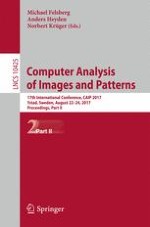2017 | Buch
Computer Analysis of Images and Patterns
17th International Conference, CAIP 2017, Ystad, Sweden, August 22-24, 2017, Proceedings, Part II
herausgegeben von: Michael Felsberg, Anders Heyden, Norbert Krüger
Verlag: Springer International Publishing
Buchreihe : Lecture Notes in Computer Science
